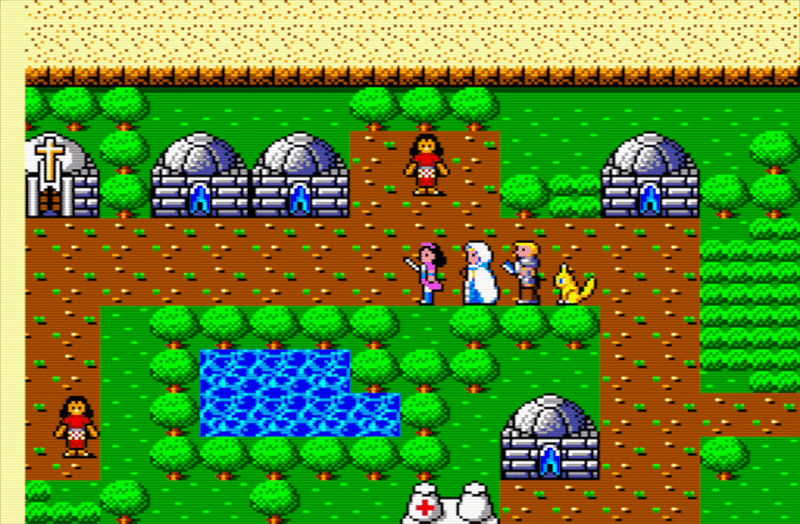Released: Dec 20, 1987
Version played: SEGA AGES (2018)
Phantasy Star is the third major pillar of the console JRPG, and despite being almost forgotten today, is inarguably the second most influential of the three. Final Fantasy, for all its western ubiquity, cannot lay claim to forever changing the design language of video games themselves the way that Dragon Quest did with its first entry, and Phantasy Star did with Online. Yet PSO’s monumental success has somewhat eclipsed perception of the mainline series itself, left to fade into relative obscurity without many modern versions and rereleases, concluded for good in 1993.
This is, I have to admit, one of the things that excites me most about Phantasy Star. It ended. It started in 1987 and then ended in 1993. Just four titles and a few bonus chapters, all release inside the span of a modern AAA development cycle. One of the worst things about video games is that with rare exceptions, they simply do not end. They may fail to sell enough and stop coming out, or maybe the team fell apart and went their seperate ways, but to make four successful games and then stop is something that almost never happens. Phantasy Star is a closed book.
Compared to its closest rivals I have to say Phantasy Star is operating on an entirely different level. Not neccesarily better qualitatively but certainly more ambitious and dense in ways that Final Fantasy will not be getting for around half a decade. There is an ambivalence that runs throughout Phantasy Star’s worldbuilding which is easily its most compelling element. This is a game about a colonizing force corrupted from within, and while you seek to restore it to glory, the questions of where that corruption truly came from is never really answered. Sure, narratively we have the soon to be incredibly common trope of behind the evil emperor was a disembodied force of darkness! But the game doesn’t really come down on what that darkness represents, the manual (what is consistent between the JP and US ones) offers only that Dark Falz influence spread through the Nobility with promises of Eternal Life. But Dark Falz is found within the Governor’s mansion, not in Lassic’s domain, he lives at the heart of humanity’s first colonial command post.
The Motavians hate the humans because they are colonizing their planet. They hated them before Lassic, and co-operate with Alisa and co. purely because getting rid of the evil guy is in everyone’s best interest. And despite all this Phantasy Star is still a game where Alisa turns out to be the long lost princess and ends the game a benevolent ruler of the entire solar system. To throwback to the entry on Dragon Quest for a second, this is indeed the first occurance in this project of what will go on to be a running JRPG tradition, games that seek to marry the restoration power fantasy of a good king with a more material understanding of its world and structures therein. And I think here that friction works extremely well, carried ultimately by the sparseness of the game and the character focus of its presentation.
Because this is still 1987 we are a long way from dedicated lore NPCs explaining how the Crystalline Dominion moved its troops east which matters because now they’re not in the west, and pretending that says something profound about slavery. Phantasy Star is not concerned with its big ideas, its concerned with providing its world with texture. NPCs travel between the three overworlds on scheduled flights, they complain when the guards are in the streets, each of their perspectives is limited by the part of the world that they inhabit. This combines with the intricately designed world which sends you criss-crossing between planets constantly, building out the map of the world not as one journey from level 1 here to 30 there, but as understanding how every disparate piece relates to the other. It’s an incredibly satisfying puzzle to put together.
And holding everything together at the heart of it all is, somehow, this project’s first instsance of what I would consider the beating heart of the genre. Not its systems or its worlds or ideology or design, but its characters. This is a game about four very different heroes coming together to form a party and take down the bad guy. When you finish the game you think about Alisa and Myau and Tylon and Lutz. Or whatever they’re called them in the translation you played. They don’t get that much characterisation, but there’s enough there to fill in the sketches, and they all come from very distinct archetypes. Myau finally getting his hero moment and growing wings to take the party to the final dungeon based on last year’s hit anime movie Castle in the Sky is a great payoff. It all comes together to form not the best JRPG of its era, but the most forward thinking and recognisable when it comes to where the genre was going.
I am very excited to continue the series and see how these seeds sprout into future entries, which I know tell a continuous generational story, which again, has a definitive ending. I’ll be done with the whole thing before Final Fantasy VI is even out. Now that’s exciting.

